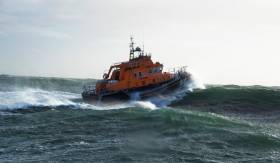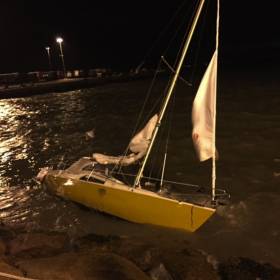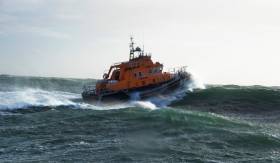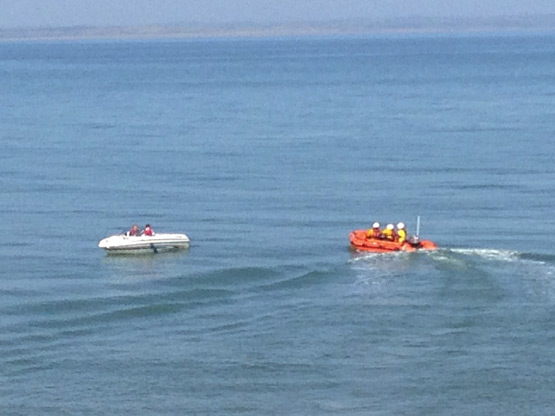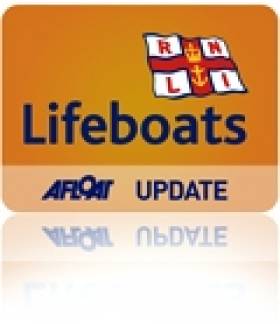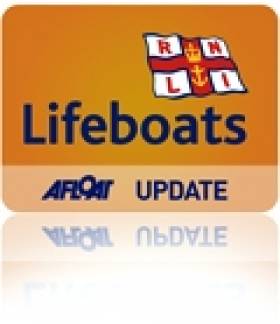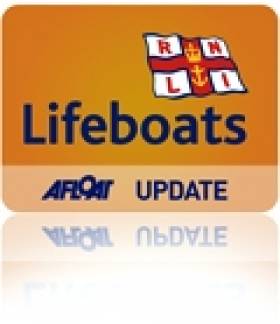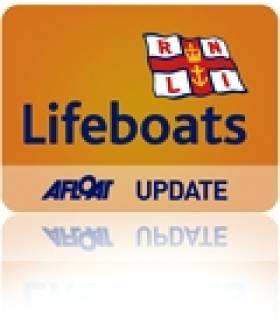Displaying items by tag: Rosslare Harbour
Rosslare Harbour Lifeboat Assists Two On Yacht Off Tuskar Rock
#RNLI - Rosslare Harbour RNLI volunteers launched their all-weather lifeboat in the early hours of this morning (Friday 28 April) following a call for help from a yacht with two men onboard off Tuskar Rock.
The 15m yacht broke its mast on a passage from Kinsale to Howth, some four miles south of Tuskar Rock Lighthouse.
The two men onboard, who are experienced sailors, decided not to run the engine for fear of fouling the propeller due to the amount of rigging and rope in the water.
They were quick to call for help, and the Irish Coast Guard requested the all-weather lifeboat from Rosslare Harbour to launch at 12.40am.
Weather conditions at the time was favourable, with a moderate sea swell and a northerly wind of Force 3 to 4.
Once on scene, the lifeboat crew towed the sailing vessel into the shelter of Rosslare Europort, where it was tied up at 4am.
Speaking following the callout, Rosslare Harbour RNLI volunteer lifeboat press officer Jamie Ryan commended the quick action of the two crew aboard the yacht.
“They did the right thing this morning and raised the alarm when they started to encounter problems. Our volunteers responded rapidly and we were delighted to help the vessel and her crew safely to shore.”
Ryan added: “We would remind anyone taking to the sea over the Bank Holiday weekend and on into the main boating season to respect the water.
“Always carry a means of calling for help and keep it within reach. Wear a personal floatation device. Check the weather and tides. Tell someone elsewhere you are going and when you will be back. Wear appropriate clothing for the conditions and your trip.”
Rosslare Lifeboat Rescues Two After Yacht Drifts Onto Rock Armour
#RNLI - The volunteer crew from Rosslare Harbour RNLI launched their all-weather lifeboat at 3.45am yesterday morning (Wednesday 14 September) following a distress call from a yacht that suffered engine failure and drifted onto rock armour.
The eight-metre vessel, with two people on board, was seeking shelter from the weather that had worsened with a strong Force 7 northwesterly gale blowing into the mouth of Rosslare Harbour.
One of the yacht’s crew was able to leave the boat and make it on to the rocks. But due to high waves and the rocks, it was not possible to attach a towline to the yacht from the lifeboat.
Two Rosslare lifeboat crew successfully managed to get the remaining occupant off the boat from the landside of the harbour while the lifeboat stood off shore providing cover.
The couple were brought to the lifeboat station to get warm and recover from their ordeal. They were also provided with dry clothes.
Speaking after the incident, Rosslare Harbour RNLI volunteer lifeboat press officer Jamie Ryan praised the efforts of the volunteer who went down to help the woman who had remained on the yacht.
"It was a challenging rescue in the early hours as the boat was getting dashed against the rocks and we needed to get the two crewmembers to safety," said Ryan. "The best way to recover them was from the landside with the lifeboat providing cover from the sea.
"The boat has suffered major damage but the two people are recovering well from the incident. The couple, who are not from Ireland, are being looked after by the people of Rosslare."
#RNLI - Rosslare Harbour RNLI volunteers launched their all-weather lifeboat at 7.30am yesterday morning (Sunday 8 May) to answer a call from the Irish Coast Guard to assist a local fishing boat with engine problems.
A very dense fog was down but the skill of the lifeboat navigators and crew ensured a quick location of the vessel, which was a short distance from Rosslare Burrow point off the Wexford coast.
"With a visibility of less than 200 metres, the lifeboat crew did extremely well to locate the vessel so quickly," said Rosslare Harbour RNLI volunteer lifeboat press officer Jamie Ryan.
"This type of weather can come in fast and can be extremely challenging when a vessel suffers engine problems. Thankfully it was a successful callout."
Hours later, Newcastle RNLI launched to assist an adult and child safely back to shore just off Newcastle Harbour in Co Down.
Three volunteer lifeboat crew launched the inshore lifeboat to assist a leisure craft which experienced engine failure. Once on scene, the crew established a tow and proceeded to Newcastle Harbour.
Newcastle RNLI Helm Niall McMurray said: "We’re always happy to help where we can and thankfully conditions were calm with no one injured."
Boulder In Net Downed Razor Clam Boat – But Capsize Could Have Been Avoided, Says MCIB
#MCIB - A large boulder snagged in its dredge net caused a razor clam boat to capsize in Rosslare Harbour earlier this year, in an incident judged to have been "predictable" by investigators.
The Marine Casualty Investigation Board (MCIB) has released its report into the incident on the FV Qui Vadis on 11 February, from which three fishermen were rescued by the quick action of the local lifeboat station and other fishing vessels in the area, as previously reported on Afloat.ie.
It was found that the boat was rolled over by a swell after it was already destabilised by the presence of a 750kg boulder in its net – with the MCIB report adding that this type of dredge fishing carries a "high risk" of fouling gear or picking up heavy objects.
The skipper and two crew were swiftly rescued, but it was noted that none was wearing a personal flotation device as required by fishing vessel regulations.
Further analysis by the MCIB determined that the lack of protection bars at the dredge mouth allowed the large boulder to enter the net, and the lack of restriction on the power of the winch allowed the vessel to lift the boulder to the point where it was dangerously unstable.
The MCIB also noted that while the vessel passed the roll test on its most recent inspection months before, that test "does not give sufficient information on a vessel’s stability" and that "only a full inclining test can establish a vessels dynamic stability".
The MCIB's full report is available to download below. The incident is not to be confused with that relating to a motor yacht with the same name also investigated by the MCIB in 2011.
#RNLI - Rosslare Harbour RNLI's volunteer lifeboat crew participating in an exercise on Sunday morning (25 October) in Rosslare Bay were diverted to a fishing vessel with an injured crewman on board.
The fishing boat was a mile northeast of Rosslare Europort when the lifeboat station was alerted at 10.30am.
First aid was given by the volunteer crew who assisted the injured fisherman on board the lifeboat, which promptly returned to station to transfer the casualty to a waiting ambulance.
Conditions at the time of the callout were good, with light westerly winds and morning sunshine.
Commenting on the callout, Rosslare RNLI volunteer lifeboat press officer Jamie Ryan said: "The RNLI volunteers were very swift in transferring the casualty to shore as they were already at sea on exercise."
#RNLI - Rosslare Harbour RNLI assisted six people in the early hours of this morning (Friday 26 June) after their yacht got into difficulty off the Wexford coast.
Volunteers were alerted shortly before 2.30am following a report from the Irish Coast Guard that a 14m yacht with six people onboard was experiencing difficulties 12 miles south east of Rosslare Harbour.
The all-weather lifeboat under coxswain Keith Miller launched at 2.55am and made its way to the scene. Weather conditions at the time were described as good with some light rain and a south east Force 4 wind blowing. Visibility was fair.
Arriving on scene at approximately 3.30am, the lifeboat crew observed that no one was in any immediate danger. The yacht, which was on passage from Poland and making its way to Dublin, had got entangled in lobster pots.
Having assessed the situation, two crew from Rosslare Harbour RNLI proceeded to launch the small inshore Y boat from the all-weather lifeboat so that they could get as close as possible to the yacht.
A towline was established and the lifeboat began to gently pull until the rope was untangled and the yacht was freed. The lifeboat stood by for 15 minutes before the yacht resumed normal passage.
Speaking following the callout, Rosslare Harbour RNLI lifeboat press officer Jamie Ryan said: "The crew of the yacht did the right thing this morning and raised the alarm when they got into difficultly.
"It was an early call out for our volunteers but they were delighted to be able to assist and ensure the six crew members on the yacht could resume their passage to Dublin safely."
#RNLI - Rosslare Harbour RNLI assisted two crew members on board a 40ft yacht which got into difficulty on Sunday night (10 May).
The alarm was raised by a member of the public at approximately 8pm who saw a boat making circles in the water and going side on to the weather, two miles inside of Tuskar Rock.
The volunteer crew launched their all-weather lifeboat at 8.05pm and were on scene four miles east, north east of Rosslare Harbour, within 20 minutes.
The yacht, with two crew members on board, had broken its main sail which then became tangled on deck. There were huge swells and breakers at the time.
On arrival, the lifeboat crew observed that the yacht’s crew had managed to disentangle the main sail. The lifeboat stood by until the yacht was free from danger and went to a safe anchorage.
Speaking following the callout, Rosslare Harbour RNLI lifeboat operations manager Dave Maloney said: "We would like to commend the member of the public who raised the alarm when they saw that the yacht was experiencing some problems.
"The sea was quite rough at the time but the crew of the yacht managed to bring the situation under control and we were happy to stand by until they were safe to proceed."
Rosslare Harbour Lifeboat Tows Lone Yachtsman To Safety
#RNLI - Rosslare Harbour RNLI was requested by the Irish Coast Guard to assist a 12-metre yacht which had lost all power due to a generator failure at 12.50am in the early hours of this morning (Monday 23 March).
The lone yachtsman, who had set out from Portsmouth for the Isle of Man, had radioed for help as the loss of power with no wind present had disabled his yacht.
Weather conditions at the time were described as very good, with a north westerly wind and a slight breeze.
A tow was established by the volunteer lifeboat crew about 25 miles northeast of Rosslare Europort off the Wexford coast. The lengthy tow saw both arrive safely back into port shortly after 6am.
Commenting on the callout, Rosslare RNLI deputy launching authority Jamie Ryan said: "It was a long night for the lifeboat crew as they made sure the lone yachtsman was brought to safety. He took the correct action in radioing for help and we were happy to assist him."
Role of Rosslare Ferries Drive Up Livestock Exports to UK by 65%
#Livestockferry – Over 16,500 animals have been exported to Britain in 2014, an increase of nearly 65% compared to last year according to the Irish Minister for Agriculture Simon Coveney.
The Minister said that in recent years Irish exporters wishing to export livestock to Britain were able to avail of roll-on, roll-off ferry services from Belfast or Larne.
However, he said early in 2014 an application was received from a shipping company for approval of a roll-on, roll-off ferry to carry livestock from Rosslare and following an inspection this ferry was approved for carriage of livestock.
The first such consignment to the UK took place in February 2014, and regular consignments of livestock have been carried from Rosslare since then, the Minister said.
For further coverage, AgriLand has a report here.
Rosslare Harbour Lifeboat Launched To Stranded Yacht Off North Wexford Coast
#RNLI - Rosslare Harbour RNLI has assisted three crew onboard a 20m yacht which got into difficulty off the north Wexford coast yesterday evening (Thursday 11 September).
The volunteer crew launched their all-weather lifeboat at 5pm to go to the assistance of a 20m sailing ketch yacht which had engine failure, some 30 miles north east of Rosslare Harbour off the Wexford coast.
The three crew on board the yacht were in no immediate danger and contacted the emergency services quickly. Sea conditions were calm with a slight south east breeze.
Once located, the yacht was taken in tow and brought to the safety of Rosslare Europort.
Speaking following the callout, Rosslare Harbour RNLI volunteer lifeboat press officer Jamie Ryan said: "We would like to commend the swift action of the yacht’s crew in contacting the coastguard who in turn alerted the volunteers at Rosslare Harbour RNLI."





























